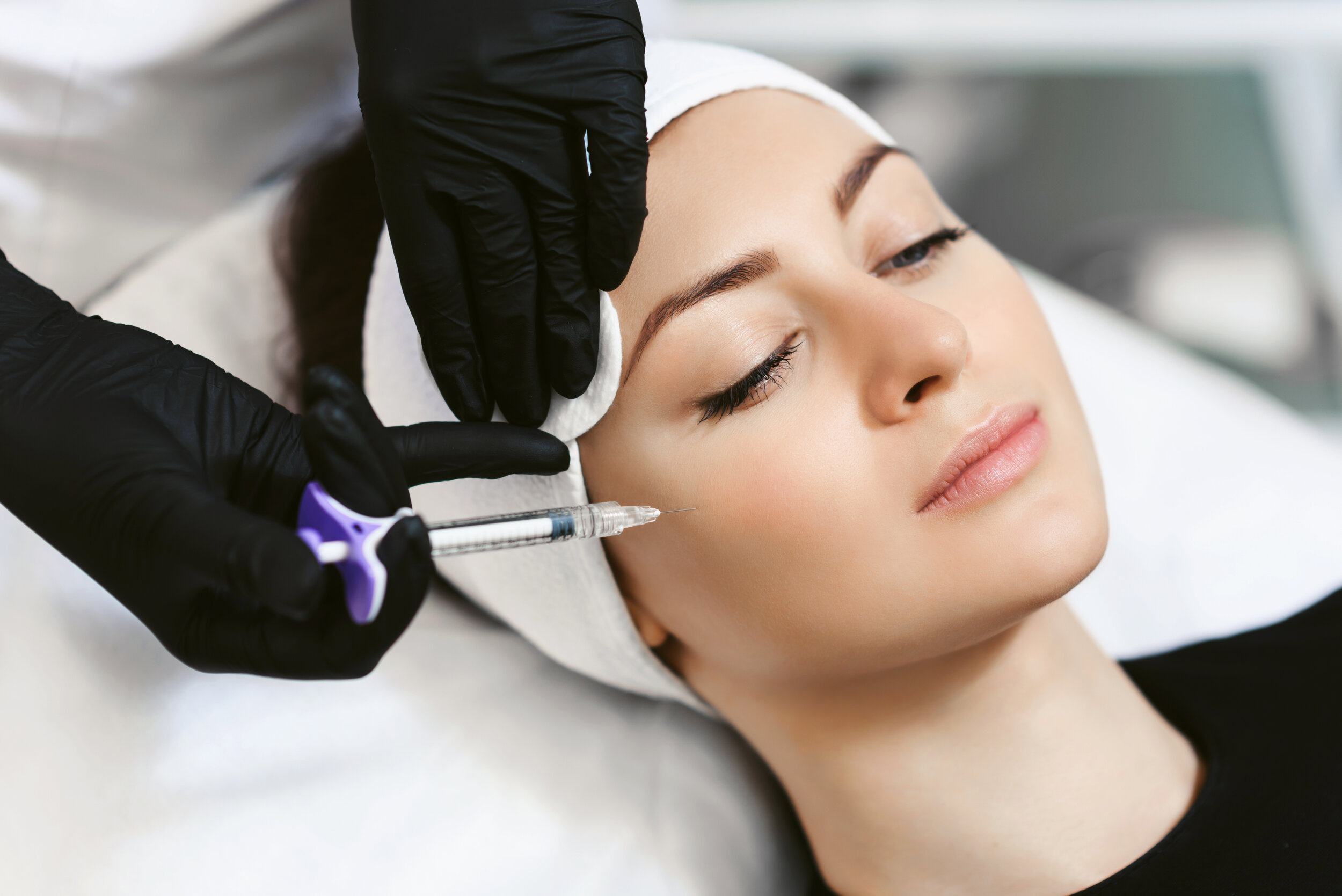
Frequently Asked Questions
Anti Wrinkle/Wrinkle relaxing Injections
What is it?
Botulinum toxin is a purified protein that is injected into the skin to relax the muscles in your face to smooth out lines and wrinkles, such as crow's feet and frown lines. The effects of Botox are reversible after a period of time and as a non-permanent cosmetic treatment, re-treatment is required after a period of time.
It was first used to treat squints by weakening the overactive eye muscle. Since then it has been used to treat a wide range of medical problems such as tics, facial spasms, and cerebral palsy. In the past 15 years or so has it become widely used for cosmetic treatments.
Is it safe?
Provided you’ve had a full consultation with a medical professional and your treatment is being administered by a qualified professional (ideally a medical professional) you should have no particular problems with using Botox.
What are the side effects?
Side effects are generally minimal. You can resume normal activities straight after treatment. At most clients experience some mild swelling and bruising which subsides after a few days or so.
Will my face look frozen?
In some cases, people have an excessive amount of Botox caused through over treatment or have Botox administered by untrained professionals using poor techniques. In these cases, the effects of Botox produce an unfavourable, unnatural look.
To ensure that you look as natural as possible, it’s recommended that you’re treated by an experienced medical professional who takes the time to accurately assess your facial structure, how much Botox you need, or whether you even need it at all. Nina, aside from being fully trained in administering Botox, is also an independent prescriber and an expert in women’s facial anatomy, as such you will only get the best and safest treatment for your face.
You should also not experience any numbness or lack of skin sensitivity more than a few days after the initial treatment.
Who should avoid having Botox?
Pregnant women or breastfeeding mothers
Patients with certain conditions affecting the connections between nerves and muscles (such as Myasthenia Gravis and Eaton-Lambert Syndrome)
People with a previous allergic reaction to botulinum toxin, or with allergies to egg or human albumin
People taking aminoglycoside antibiotics (such as clarithromycin, gentamicin etc.)
Anyone with a skin infection in the area to be treated
Caution should be exercised in any patients taking blood-thinning medication such as Warfarin, Rivaroxaban and Clopidogrel, simply due to the possibility of severe bruising
When should I begin treatments?
The sooner the better as an anti-ageing preventative. However whilst there is no particular age limit, those with deeper wrinkles may benefit more from dermal fillers as opposed to this. A full consultation with Nina will help ascertain what the most suitable course of treatment is to meet your needs.
When will I see effects after treatment?
Effects may take up to 2 weeks post-treatment to fully show, though this can be sooner. Re-treatment is usually at least every 3 months, this varies from person to person ranging from 2 to 5 months on average.
Dermal Fillers
What are dermal fillers?
Dermal fillers are made from a product called hyaluronic acid, which naturally occurs in the body. Its key role is to absorb water and transport nutrients to the skin ensuring that the structure and volume are maintained. As we age the production of HA in the body decreases as such the skin loses volume and elasticity. Dermal fillers help to re-volumise the skin by injecting HA back into various areas of the face.
When can I expect to see results after treatment?
The effects of dermal are noticeable immediately after the procedure. These effects are long-lasting, non-permanent and reversible. Generally, most clients return for a follow-up treatment approximately every 6-12 months.
Are there any side effects?
Most reactions are generally minimal and temporary. You should expect some swelling and you may have some slight bruising however these reactions are expected to subside within a couple of days.
What happens during treatment?
Prior to treatment, we remove any make-up and cleanse the area to be treated. We use a topical anaesthetic on the area which we will inject. The product is placed using a cannula which helps to keep swelling and bruising to a minimum. Discomfort during the treatment should be minimal. However, if you are sensitive we can use a local anaesthetic although in most cases this is not necessary.
The treatment takes approximately 30 minutes.
What happens post-treatment?
Post treatment we advise against rubbing the area that has been treated and to avoid any beauty treatments such as facial massage, saunas and extreme temperatures for up to 2 weeks after.
Facial Contouring
What is non-surgical facial contouring?
Facial contouring involves the use of dermal fillers to alter and enhance the contours of the face to achieve a desired appearance. This can be done using various filler treatments and is tailored to the individual’s facial anatomy and preferences.
How long does facial contouring last?
Fillers generally last for 6-12 months, with this being dependent on the patient’s metabolism and activity levels.
Does facial contouring hurt?
Similarly, when we inject Botox, you will feel a tiny prick as the needle enters, but it is not an uncomfortable sensation. We always use complimentary local anaesthetic to minimise any discomfort. Many of our clients say they don’t even feel the injections and do not experience uncomfortable bruising or after-effects.
What happens post-treatment?
Using top-brand modern fillers means that most of the time there are minimal or no after-effects. A little short-term swelling or bruising is possible and the pinpricks where the injections are placed may show for a few hours. Any visible effects are almost always minimal and can be easily covered with makeup.
It is not recommended that you go to the gym, wear makeup or go out into the sun for 24 hours, but after that, you will be able to return to your normal routine.
Lip Augmentation
What do lip fillers do?
Lip filler for lip augmentation is a dermal filler treatment in the lips. It can add volume to thin lips, correct uneven lip shape, smooth out smoker’s lines and be used to treat scars on the lips with dermal fillers. Here we use the highest quality and market-leading brand, Juvederm.
What are lip fillers made of?
Lip fillers are made of Hyaluronic Acid (HA), which is a substance that naturally occurs in the dermis of the skin. It can be found in many beauty products, as it is a hydrophilic molecule, meaning that it attracts water. It can hold up to 1000 x its own weight in water making it an excellent hydrator. We hand-pick our lip filler products using Nina’s expert knowledge in Pharmacology, using only the safest and most reputable brands. We don’t administer permanent lip fillers at Update Aesthetics.
Are lip fillers safe?
Lip fillers are a cosmetic procedure administered via injections. Provided you are having treatment with a qualified, medical professional using a quality product you should not experience any issues. Nina is a Harley Street-trained professional and certified medic who will safely guide you through the treatment.
Does lip augmentation hurt?
Lip filler injections are relatively painless though this does vary from person to person and their comfort levels with needle injections. The lip fillers also have a dose of the painkiller lidocaine mixed in the gel, which will help to numb the area so any discomfort is kept to a minimum. Nina has plenty of experience in administering lip filler injections with good technique so this also contributes to the comfort level of the client.
What happens during the treatment?
The treatment involves the application of a cream or dental block to numb the lips so that the treatment is comfortable.
A tiny needle is placed into the lips or lipstick lines to give the desired results. Some gentle moulding is done as part of the treatment. The process usually takes around 20 minutes. There is usually some swelling after the treatment; this can be reduced with the application of an ice pack. We may ask you to apply this for a few minutes after the treatment.
What can I expect post-treatment?
Initially, there is some swelling and the lips may feel bigger than usual which can feel strange. However, please bear in mind that the swelling will soon go down to reveal the final result. This usually takes 1-2 weeks but can take longer. We may advise you to apply arnica cream to reduce bruising but it also helps to hydrate the lips as the swelling settles. Occasionally, you may be able to feel the lip filler, in which case gentle massage may be helpful.
How long does the filler last?
The HA lip filler gel will last at least 6 months and sometimes even up to 12 months, according to the manufacturer’s literature.

